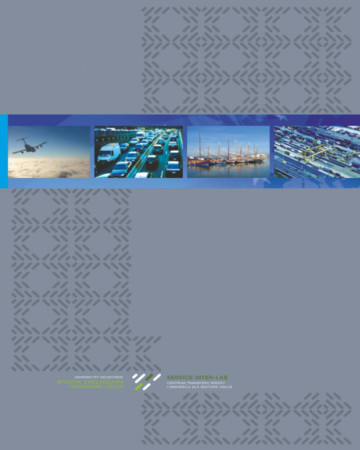
ISSN: 1644-275X
eISSN: 2353-3005
OAI
DOI: 10.18276/ptl.2018.41-09


Issue archive /
nr 1 (41) 2018
ELASTYCZNE SYSTEMY TRANSPORTU JAKO ELEMENT PODAŻY USŁUG TRANSPORTU PASAŻERSKIEGO NA PRZYKŁADZIE LUKSEMBURGA
(FLEXIBLE TRANSPORT SYSTEMS AS AN ELEMENT OF THE SUPPLY OF PASSENGER TRANSPORT SERVICES ON THE EXAMPLE OF LUXEMBOURG)
| Authors: |
Tomasz
Kwarciński
Uniwersytet Szczeciński |
| Keywords: | flexible transport systems Luxembourg supply of transport services |
| Data publikacji całości: | 2018 |
| Page range: | 9 (97-105) |
| Klasyfikacja JEL: | R41 R42 |
Abstract
The article presents an analysis of flexible transport systems found in Luxembourg. The presented characteristics
of flexible systems show that they constitute a valuable supplement for regular transport.
This applies to areas characterized in particular by low demand for transport services and a peripheral
location. The low demand is influenced by a small population, peripheral location and the changing
demographic structure of the population
In practical terms, three different solutions for flexible transport systems are presented. Their differentiation
takes into account the needs of residents. The differentiating criterion is, among others, the time
of providing services. One of the presented systems (Bummelbus) shows that systems can also play an
important role in occupational activation of residents.
Download file
Article file
Bibliography
| 1. | Bummelbus (2018). Pobrane z: http://www.esch-sur-sure.lu/espace-citoyen/mobilite/bummelbus (5.01.2018). |
| 2. | Currie, G. (2010). Quantifying Spatial Gaps in Public Transport Supply Based on Social Needs. Journal of Transport Geography, 1 (18), 31–41. DOI: 10.1016/j.jtrangeo.2008.12.002. |
| 3. | Département des transports (2018). Pobrane z: http://www.mt.public.lu/functions/contact/index.php (5.01.2018). Energy, Transport and Environment Indicators, 2017 Edition (2017). Luxembourg: Publications Office of the European Union. |
| 4. | Eurostat (2018a). Pobrane z: http://ec.europa.eu/eurostat/data/database (5.01.2018). |
| 5. | Eurostat (2018b). Pobrane z: http://ec.europa.eu/eurostat/tgm/table.do?tab=table&init=1&language=en&pcode=tec00114& plugin=1 (30.01.2018). |
| 6. | Kwarciński, T. (2016). Dostępność publicznego transportu zbiorowego na obszarach wiejskich w Polsce. Aspekty metodyczne i pragmatyczne. Szczecin: Wydawnictwo Naukowe Uniwersytetu Szczecińskiego. |
| 7. | Mężyk, A. (2013). Elastyczne formy transportu publicznego w obsłudze komunikacyjnej regionu. W: M. Michałowska (red.), Współczesne uwarunkowania rozwoju transportu w regionie (s. 262–270). Katowice: Wydawnictwo Uniwersytetu Ekonomicznego. |
| 8. | Mobil 2020. Mobilitéit déi beweegt. Ministre Des Transports. Pobrane z: www.mt.public.lu/presse/actualite/2007/10/01mobil2020/brochure.pdf (5.01.2018). |
| 9. | Mulley, C., Nelson, J.D. (2009). Flexible Transport Services: A New Market Opportunity for Public Transport. Research in Transportation Economics, 1 (25), 39–45. DOI: 10.1016/j.retrec.2009.08.008. |
| 10. | Sales-Lentz (2018). Pobrane z: www.sales-lentz.lu/en/individuel/public-transport (5.01.2018). |
| 11. | Statec (2018a). Pobrane z: http://www.statistiques.public.lu/fr/acteurs/statec/index.html (5.01.2018). |
| 12. | Statec (2018b). Pobrane z: http://www.statistiques.public.lu/stat/TableViewer/tableView.aspx (5.01.2018). |
| 13. | Statec (2018c). Pobrane z: http://www.statistiques.public.lu/stat/TableViewer/tableView.aspx?ReportId=12853&IF_Language=eng (5.01.2018). |
| 14. | Statec (2018d). Pobrane z: http://www.statistiques.public.lu/stat/TableViewer/tableView.aspx?ReportId=13513&IF_Language=eng&MainTheme=4&FldrName=7&RFPath=7049%2c13897%2c13901 (5.01.2018). |
| 15. | Velaga, N.R., Nelson, J.D., Wright, S.D., Farrington, J.H. (2012). The Potential Role of Flexible Transport Services in Enhancing Rural Public Transport Provision. Journal of Public Transportation, 1 (15), 111–131. DOI: 10.5038/2375-0901.15.1.7. |
| 16. | Wright, S. (2013). Designing Flexible Transport Services: Guidelines for Choosing the Vehicle Type. Transportation Planning and Technology, 1 (36), 76–92. DOI: 10.1080/03081060.2012.745757. |